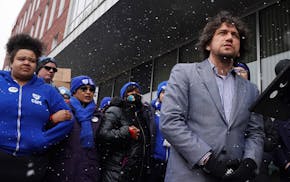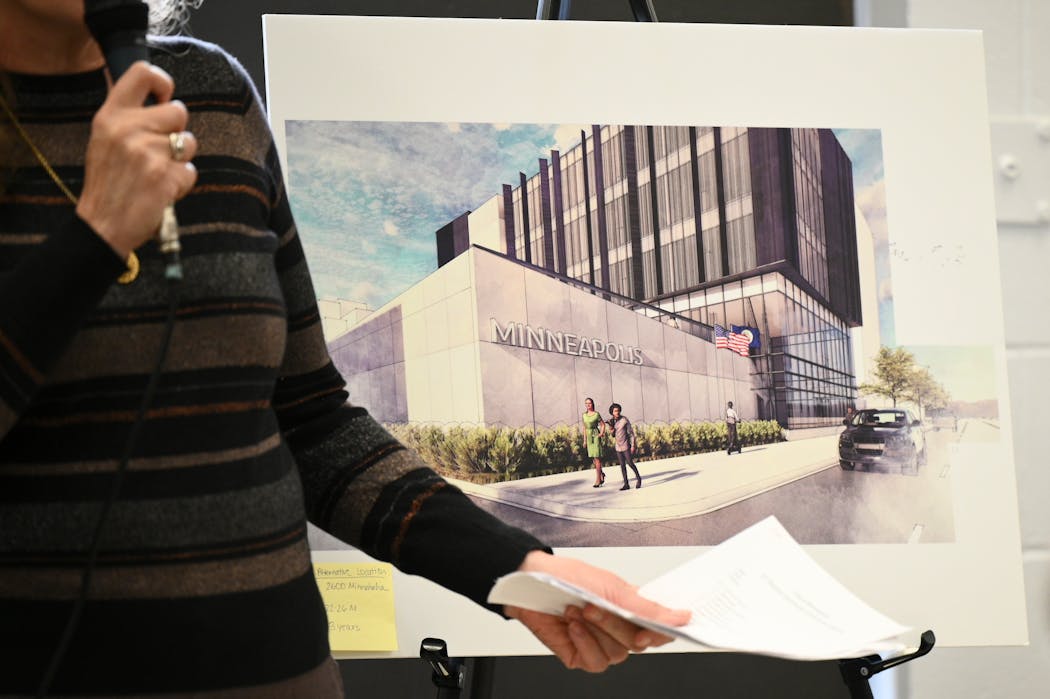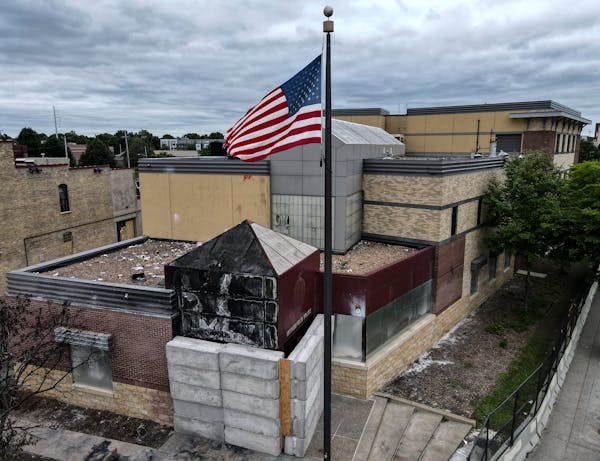The Third Precinct's charred remains sit vacant on a south Minneapolis street corner, encircled by barricades, tall fences and razor wire. Debris litters the rooftop and paint splatter drips down giant concrete blocks obstructing the front entrance.
It serves as a painful reminder of the civil unrest sparked by the murder of George Floyd by a white police officer. And it persists as a political talking point by those who have denounced the building as a "monument to anarchy" or an enduring symbol of police brutality.
Even as wide swaths of Lake Street have emerged from the ashes to rebuild storefronts destroyed during the riots of May 2020, the precinct stands halted in time. The boarded-up hulk baffles neighbors, who have grown increasingly exasperated with city leaders' inaction. Now, nearly three years later, residents are being asked to decide: renovate the existing structure for an estimated $12 million or construct a new headquarters four blocks away at a city-owned lot for roughly twice the price.
Hundreds attended a series of listening sessions earlier this month to weigh in on the proposal, which many criticized as a "false choice." Some expressed anxiety about the inability to quell a surge in violent crime, while a majority who spoke were aghast at the prospect of returning officers to a site notorious for its history of renegade cops.
"We don't dispute that our community requires policing. We just can't have it next to us," said Chris Mozena, executive director of the Hook & Ladder Theater, a renovated firehouse that abuts the defunct precinct.
"Until that site is bulldozed, you don't have an opportunity to begin healing and talking about what kind of future we can have together as a community. Anything else is just insulting."
Two options presented
Residents packed inside the performing arts center last week, eager to hear long-awaited plans for what's become a neighborhood eyesore. They filtered past colorful architectural renderings — one depicting a rehabbed version of the original precinct, with a garden leading toward its main entry; the other, a five-story new headquarters overlooking Minnehaha Avenue atop a glass-walled atrium.
Interim City Operations Officer Heather Johnston addressed a standing-room-only crowd by first acknowledging that "our police officers murdered George Floyd at 38th and Chicago" and, as a result of civil unrest, the building was set ablaze.
She explained that, over the past two years, Third Precinct officers have operated out of an office building downtown, hampering response times to the southeastern quadrant of the city they serve. Since then, city officials have researched 28 potential sites within the precinct's geographic boundaries, but found only two that best meet their criteria for space, zoning and accessibility.
"Why is there no third option?" a woman interjected. "This is manufactured consent!"
At all five public meetings, hecklers rebuked the process as an attempt to ram through a decision on where to rebuild a precinct before rectifying the harm caused by the officers it would eventually house.
"There has been nothing — absolutely nothing — to evidence that MPD has changed its culture and its ways," said Stacey Gurian-Sherman, a local attorney recently nominated to sit on the new Minneapolis police oversight panel. Her comments elicited rousing applause from several dozen attendees at the Midtown Global Market.
Lt. Richard Zimmerman, the longtime head of MPD's homicide unit, grabbed the mic to counter that community members who call 911 desperate for help, or have been shot, shouldn't have to wait upward of 30 minutes for first responders to drive all the way from downtown.
"That's why I don't care which precinct y'all decide, but we do need a precinct," said Zimmerman, emphasizing that citizens deserve access to a police station in their own neighborhood to file a complaint.
Emotions boiled over as residents pushed back at city leaders, demanding evidence that response times have slowed without a centrally located precinct. The city did not provided that data.
A Star Tribune analysis has found that the volume of 911 police calls exploded across Minneapolis following Floyd's death and remained significantly elevated through last year, as the department hemorrhaged officers — a confluence of events that has left emergency callers waiting longer for squads to arrive.
From call pickup to officer arrival, average citywide police response times increased most dramatically from 2019 through 2021. Waits remained 4 minutes longer than pre-pandemic averages for critical emergencies in 2022, according to figures obtained through a data practices request.
The Third Precinct's average response time for high-priority calls was 13 minutes in 2019, hit 16 minutes in 2021 and climbed to 18 minutes last year. The Fifth Precinct, which covers neighborhoods like Whittier and Uptown on city's southwest side, recorded even slower response times during that period.
Resistance to plans
Just before the second anniversary of Floyd's death — and amid continued silence from the city — a neighborhood organization stepped in to solicit feedback on the future of the dilapidated precinct.
Although only a few hundred people participated, 75% said the building should not be reopened as a police station. Instead, residents suggested a variety of alternative uses, like a memorial garden, youth center or museum.
"They want to see it become a pillar of the community that does not look like a fortress on the corner of one of the most important intersections in the area," said Bennett Olupo, an organizer with the Longfellow Community Council.
This year the neighborhood group is working with DeYoung Consulting to distribute a comprehensive survey gathering input on the two proposed Third Precinct sites on behalf of the city. Those results are expected to be presented to the City Council in June, though a timetable on a formal decision remains unclear.
For some, the public meetings provided an opportunity to help process lasting trauma inflicted by the aftermath of Floyd's death. In small group discussions, neighbors recalled the fear and uncertainty of the riots, when they stayed out late defending their homes and businesses, or dodged rubber-coated bullets while demonstrating outside the Third Precinct.
Many expressed disappointment in the city's overall lack of engagement on the topic and an unwillingness to select either option.
"Whatever you do, you're gonna have resistance," said Frederick Brathwaite, who co-owns Mama Sheila's House of Soul in south Minneapolis. "... because there's no resolution between the community and cops.
"It's like this: You have bees in this hive who scare people — who beat up people, who kill people, who do a lot of bad things."
"Who also save lives!" Molly Hillenbrand, a lifelong Southside resident, interjected from across the room.
"You take these bees, and you put them in another building," Brathwaite continued. "They are still bees. And they will sting you."
In an interview, Hillenbrand said bringing officers back to the original precinct would provide peace of mind and be more cost-effective for taxpayers.
"It's ready to go. It's repairable," said Hillenbrand, who works for the city Park and Recreation Board. "To me it comes down to dollars and cents."
Solution remains elusive
Minneapolis has spent over $780,000 to keep the site in working order since rioters torched the precinct, according to financial records obtained through a data request. It remains structurally sound, despite fire damage to the east wing.
Few cops who evacuated the precinct that night remain on the force.
At the Hook and Ladder Theater, Diane Napper recounted feeling mortified about the rise in crime and how, for the first time in 30 years, she feels unsafe in Minneapolis. But she refuses to give up on the city she loves.
"We gotta have police ... and we want them to be close to us when we have a problem," said Napper, a graphic designer, who suggested rebuilding the Third Precinct in a way that both improves the space for police and honors the community.
"When a tragedy occurs, you can take ownership of that trauma by rebuilding in that same spot and making something better and saying we're not going to allow what happened there to haunt us the rest of our lives."
Staff writers Susan Du and Jeff Hargarten contributed to this report.

Lakewood Cemetery in Minneapolis opens new Welcome Center
Man killed in domestic incident in Coon Rapids, Sheriff's Office says

U of M's interim president meets with pro-Palestinian protest leaders

Legendary boys hockey coach Randolph loses his job



